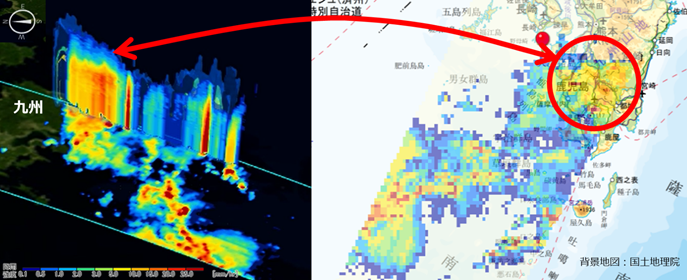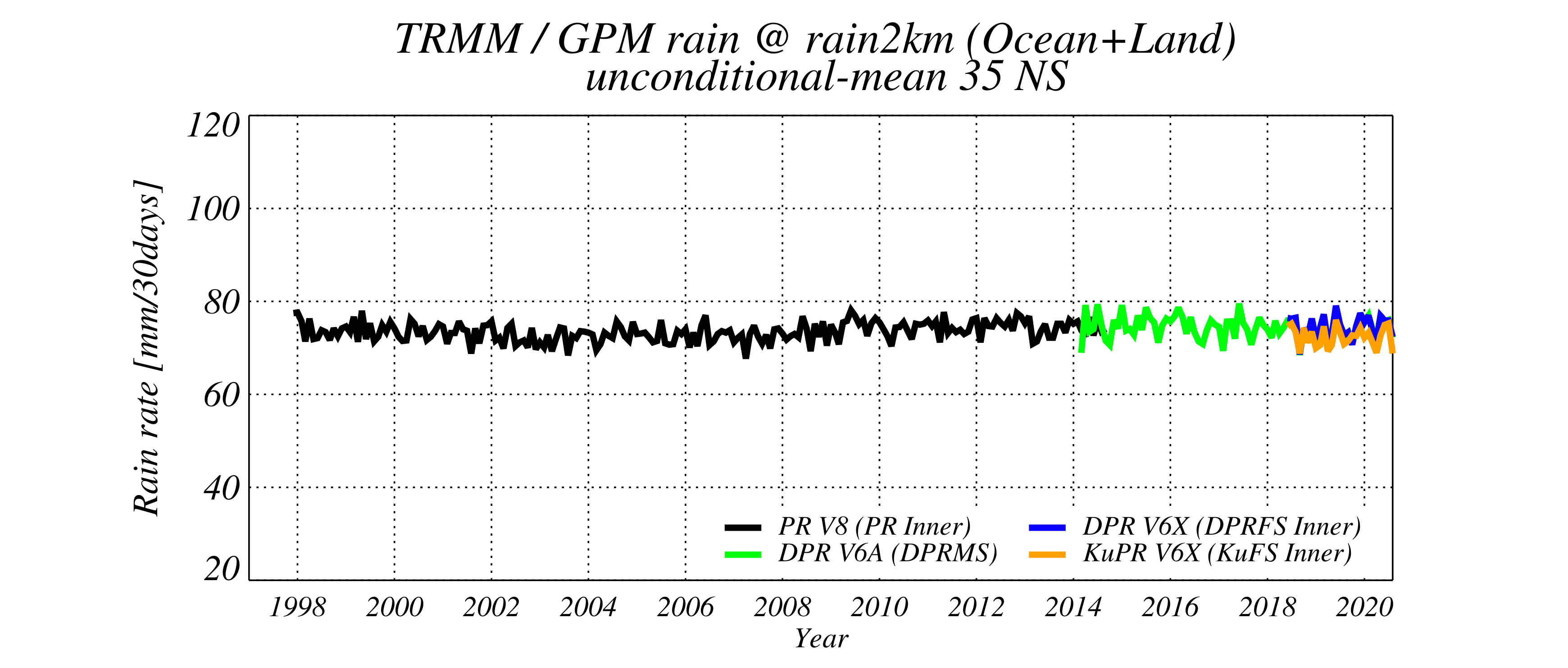Research of Precipitation Measuring Mission
JAXA Supercomputer System Annual Report April 2020-March 2021
Report Number: R20ER1400
Subject Category: Space Technology
- Responsible Representative: Riko Oki, Earth Observation Research Center
- Contact Information: Takuji Kubota(kubota.takuji@jaxa.jp)
- Members: Tomohiko Higashiuwatoko, Takeshi Masaki, Munehisa K. Yamamoto, Takuji Kubota, Tomoko Tashima, Moeka Yamaji
Abstract
Development for a major update of the TRMM Precipitation Radar (PR) and the GPM Dual-frequency Precipitation Radar (DPR) algorithm with long-term observation data.
Reference URL
Please refer to https://www.eorc.jaxa.jp/TRMM/index_e.htm .
Reasons and benefits of using JAXA Supercomputer System
The TRMM/GPM radar algorithm is being developed in NASA and JAXA with Japan-US collaboration. Therefore, the progress of the algorithm development on the Japanese side may affect the overall schedule. In particular, the development of the Level 1 algorithm and the creation of long-term product are located at the most upstream process, and therefore, it has the highest priority. In this point, long-term processing using JSS2 is very affectable because JSS2 provides strict project progress management, emergency response, and detailed user support by the operation side.
It is no exaggeration to say that the project cannot be achieved without JSS2.
Achievements of the Year
The GPM DPR continues the observation even now and it observed the precipitation zone in the Kyushu region that occurred in conjunction with the Baiu front that became very active in July 2020 (Figure 1).For the development of the TRMM PR and GPM DPR radar algorithms whose major update are scheduled in FY2021, a long-term test process was conducted from 2014 to 2020. The long-term tests were used to revise the DPR level 1 algorithm for correction of the gain for phase shifter, to revise the observation distance, to recalculate the backscattering cross section (σ0) in the DPR level 2 algorithm which input the DPR level 1 product, and to improve the precipitation estimation algorithm using these. In the product evaluation, it was found that there were some discrepancies between the precipitation estimated by the KuPR single frequency algorithm (orange line in Figure 2) and that of the DPR dual frequency algorithm (blue line in Figure 2). These discrepancies will be expected to improve in next major update. The parallel processing in JSS2 reduced the processing time and accelerated the development cycle.

Fig.1: Vertical Structures of Precipitation Zones Associated with the Baiu Front Observed by the Global Precipitation Measurement (GPM) Dual-Frequency Precipitation Radar (DPR) at 12:40 (Japan Time) on July 5, 2020.

Fig.2: A trend of the precipitation of TRMM PR and GPM DPR at 2km height. Monthly unconditional mean in tropical region (35N-35S). Black line: TRMM PR, Green line: GPM DPR dual frequency product (V06A), Blue line: GPM DPR dual frequency product(V06X), Orange line: GPM KuPR single frequency product (V06X).
Publications
- Peer-reviewed papers
1.T. Masaki, T. Iguchi, K. Kanemaru, K. Furukawa, N. Yoshida , T. Kubota, and R. Oki, 2020: Calibration of the Dual-frequency Precipitation Radar (DPR) Onboard the Global Precipitation Measurement (GPM) Core Observatory, IEEE Trans. Geosci. Remote Sens., https://doi.org/10.1109/TGRS.2020.3039978
2. Ikuta, Y., K. Okamoto, and T. Kubota, 2020: One-Dimensional Maximum Likelihood Estimation for Spaceborne Precipitation Radar Data Assimilation, Q. J. R. Meteorol. Soc., https://doi.org/10.1002/qj.3950.
3. S. Seto, T. Iguchi, R. Meneghini, J. Awaka,T. Kubota, T. Masaki and N. Takahashi, 2020: The Precipitation Rate Retrieval Algoirthms for the GPM Dual-frequency Precipitation Radar, J. Meteor. Soc. Japan, https://doi.org/10.2151/jmsj.2021-011.
4. T. Kubota, S. Seto, M. Satoh, T. Nasuno, T. Iguchi, T. Masaki, J. M. Kwiatkowski, and R. Oki, 2020: Cloud assumption of Precipitation Retrieval Algorithms for the Dual-frequency Precipitation Radar, J. Atmos. Oceanic Technol. 37, 2015-2031, https://doi.org/10.1175/JTECH-D-20-0041.1
- Invited Presentations
T. Kubota et al., Evaluation of CLOUD LIQUID WATER DATABASE USING GLOBAL CLOUD-SYSTEM RESOLVING MODEL FOR GPM/DPR ALGORITHMS, IGARSS2020, Sep 2020.
- Oral Presentations
1. T. Kubota et al., Cloud liquid water database derived from a global cloud-system resolving model for precipitation retrievals of GPM/DPR observations, JpGU-AGU Joint Meeting 2020, July 2020.
- Poster Presentations
1. T. Kubota et al., Cloud liquid water assumption of Precipitation Retrieval Algorithms for the Dual-frequency Precipitation Radar onboard the GPM Core Observatory, AGU2020, Dec 2020.
- Web
JAXA Global Rainfall watch
https://sharaku.eorc.jaxa.jp/GSMaP/index.htm
EORC TRMM
https://www.eorc.jaxa.jp/TRMM/index_e.htm
Usage of JSS
Computational Information
- Process Parallelization Methods: N/A
- Thread Parallelization Methods: N/A
- Number of Processes: 1
- Elapsed Time per Case: 24 Hour(s)
Resources Used(JSS2)
Fraction of Usage in Total Resources*1(%): 0.05
Details
Please refer to System Configuration of JSS2 for the system configuration and major specifications of JSS2.
| System Name | Amount of Core Time(core x hours) | Fraction of Usage*2(%) |
|---|---|---|
| SORA-MA | 0.00 | 0.00 |
| SORA-PP | 13,324.66 | 0.10 |
| SORA-LM | 0.00 | 0.00 |
| SORA-TPP | 0.00 | 0.00 |
| File System Name | Storage Assigned(GiB) | Fraction of Usage*2(%) |
|---|---|---|
| /home | 60.40 | 0.06 |
| /data | 71,147.32 | 1.37 |
| /ltmp | 10,904.95 | 0.93 |
| Archiver Name | Storage Used(TiB) | Fraction of Usage*2(%) |
|---|---|---|
| J-SPACE | 26.10 | 0.86 |
*1: Fraction of Usage in Total Resources: Weighted average of three resource types (Computing, File System, and Archiver).
*2: Fraction of Usage:Percentage of usage relative to each resource used in one year.
Resources Used(JSS3)
Fraction of Usage in Total Resources*1(%): 0.05
Details
Please refer to System Configuration of JSS3 for the system configuration and major specifications of JSS3.
| System Name | Amount of Core Time(core x hours) | Fraction of Usage*2(%) |
|---|---|---|
| TOKI-SORA | 0.00 | 0.00 |
| TOKI-RURI | 199.37 | 0.00 |
| TOKI-TRURI | 0.00 | 0.00 |
| File System Name | Storage Assigned(GiB) | Fraction of Usage*2(%) |
|---|---|---|
| /home | 19.87 | 0.01 |
| /data | 70,880.29 | 1.19 |
| /ssd | 103.31 | 0.05 |
| Archiver Name | Storage Used(TiB) | Fraction of Usage*2(%) |
|---|---|---|
| J-SPACE | 26.10 | 0.86 |
*1: Fraction of Usage in Total Resources: Weighted average of three resource types (Computing, File System, and Archiver).
*2: Fraction of Usage:Percentage of usage relative to each resource used in one year.
JAXA Supercomputer System Annual Report April 2020-March 2021


